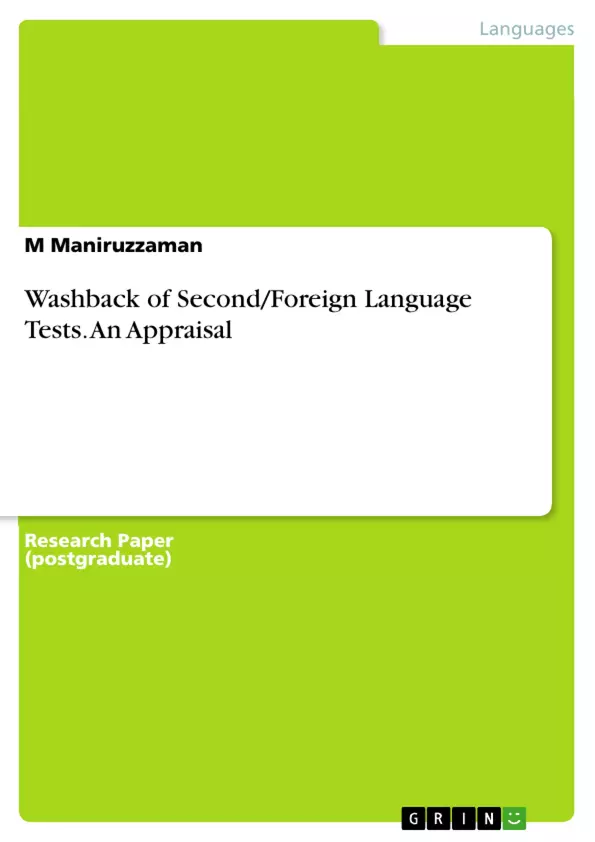An external test or public examination, particularly in a second/foreign language such as IELTS, TOEFL, HSC examination in English, etc might have considerable impact on the stakeholders including teachers, learners, parents, administrators, the institution, the educational system and society as a whole. The effect a test has on the different components of the educational process of a second/foreign language is termed ‘washback, either beneficial or harmful at both the micro and macro level. The current paper, firstly, purports to be an appraisal of the concept of ‘washback’, secondly, examines its nature and functions as revealed by different proponents and researchers, and, finally, ascertains its role in second/foreign language education.
Inhaltsverzeichnis (Table of Contents)
- Abstract
- Introduction
- Washback
- Background and Origin
- Definition
Zielsetzung und Themenschwerpunkte (Objectives and Key Themes)
This paper appraises the concept of "washback" in second/foreign language testing, examines its nature and functions as described by various researchers, and determines its role in second/foreign language education. The study explores both the positive and negative impacts of testing on various stakeholders.
- The definition and origin of "washback" in language testing.
- The impact of tests on teaching and learning practices.
- The influence of washback on learners, teachers, and the educational system.
- The examination of positive and negative washback effects.
- The role of washback in shaping second/foreign language education.
Zusammenfassung der Kapitel (Chapter Summaries)
Abstract: This abstract introduces the concept of washback in second/foreign language testing, highlighting its impact on various stakeholders and the educational process. It previews the paper's aim to appraise the concept of washback, analyze its nature and functions, and determine its role in second/foreign language education.
Introduction: This chapter establishes the context of external language tests, such as IELTS and TOEFL, and their significant influence on teaching and learning. It traces the historical evolution of public examinations from ancient China to modern-day systems, emphasizing their global prevalence and shared characteristics. The chapter also details the various functions of public examinations, including assessing student competence, discrimination for future opportunities, and providing evidence of institutional effectiveness. The introduction lays the groundwork for exploring washback as a consequence of these examinations.
Washback: Background and Origin: This section delves into the relatively recent emergence of the term "washback" in applied linguistics. It discusses the growing research interest in the impact of tests on society and individuals, citing key studies like Kellaghan et al. (1982), Wesdorp (1982), and Hughes (1988). The chapter further examines the shift in focus from the test itself to its effects on learning and teaching, highlighting the landmark study by Wall & Alderson (1993) and the ongoing debate on whether tests should influence the curriculum or vice versa.
Washback: Definition: This section provides a formal definition of a test or examination within the context of second/foreign language education, emphasizing its role in eliciting information about a testee's ability or knowledge. This succinct yet crucial chapter sets the parameters for how the term "washback" functions within the overall argument of the paper.
Schlüsselwörter (Keywords)
Second/foreign language tests, washback, positive washback, negative washback, test impact, curriculum, teaching, learning, stakeholders, assessment, applied linguistics.
Frequently Asked Questions: A Comprehensive Language Preview
What is the main topic of this document?
This document is a comprehensive preview of a paper that appraises the concept of "washback" in second/foreign language testing. It examines washback's nature, functions, and role in second/foreign language education, exploring both positive and negative impacts on various stakeholders (learners, teachers, and the educational system).
What does the Table of Contents include?
The table of contents covers an abstract, introduction, and a section on washback (further divided into background and origin, and definition). It provides a structured overview of the paper's organization.
What are the key objectives and themes explored in this paper?
The paper aims to define and trace the origin of "washback," analyze its impact on teaching and learning, investigate its influence on different stakeholders, examine both positive and negative effects, and ultimately determine washback's role in shaping second/foreign language education.
What are the chapter summaries provided in the preview?
The preview offers summaries of the abstract, introduction, and the sections on washback's background and origin, and its definition. These summaries briefly describe the content and purpose of each section.
The abstract introduces the concept of washback and its impact. The introduction sets the context of external language tests and their influence on teaching and learning. The washback sections delve into the term's emergence, research surrounding its impact, and its formal definition within the context of language education.
What are the keywords associated with this paper?
The keywords highlight the core concepts: Second/foreign language tests, washback (positive and negative), test impact, curriculum, teaching, learning, stakeholders, assessment, and applied linguistics.
What types of tests are being discussed?
The preview mentions external language tests like IELTS and TOEFL as examples of tests that have a significant impact on teaching and learning and are relevant to the discussion of washback.
What is washback?
While a full definition is provided in the paper, the preview introduces washback as the impact of tests on teaching and learning practices and the various stakeholders involved in the educational process. It explores both the positive and negative consequences of this impact.
Who are the stakeholders impacted by washback?
The stakeholders affected by washback are learners, teachers, and the educational system as a whole.
- Citar trabajo
- Prof. Dr. M Maniruzzaman (Autor), 2014, Washback of Second/Foreign Language Tests. An Appraisal, Múnich, GRIN Verlag, https://www.grin.com/document/278338



